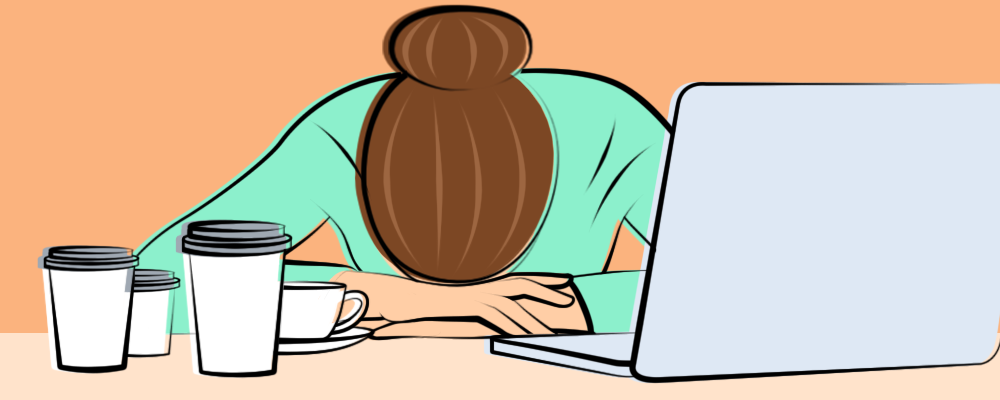Learn how to deal with migraine triggers at the office, what to do when you get a migraine at work, and how to talk to your colleagues about your condition.
Anyone who has migraine knows how painful and debilitating the symptoms can be. It can be difficult to move – let alone think clearly – when in the throes of an attack. That makes it incredibly challenging to continue one’s responsibilities when a migraine sets in at work.
As migraines tend to occur during our most productive years (late teens to 50s), it isn’t all-too surprising that migraine is the sixth highest cause of disability worldwide. In the UK, for example, 25 million working or school days are lost every year due to migraine alone. Even when work isn’t actually missed, productivity can take a massive hit due to migraine.
Migraine leads to high costs for both employers and sufferers themselves, due to medical expenses, use of sick leave, and the need for short and long-term disability. One study in the US found that the costs for migraineurs are an average of $8,924 more per year compared to for people without migraine.
And there is the personal impact, too. One third of migraineurs say that they are worried about their long-term financial security because of their condition, and almost 45% of chronic migraine sufferers worry they will lose their job.
Migraine can put a huge strain on one’s professional life. So what are some things you can do if you are living with migraine and also working at the same time? In this article, we will cover common workplace triggers and how to reduce them, as well as how to approach your colleagues about your condition.
Common migraine triggers in the workplace
Offices can be overloaded with potential triggers. The most common workplace triggers include:
- Stress. Stress is a major migraine trigger. And what’s one of the most common sources of stress in our lives? Our jobs.
- Lighting. Bright, flickering, and fluorescent lights can all be problematic. Unfortunately, many offices are filled with this kind of harsh lighting.
- Screens. Looking at screens all day can be tricky for migraine sufferers. And with technology at the center of so many office environments, it can be next to impossible to avoid them.
- Noise. From loud voices to the constant ringing of phones, a noisy workplace environment might trigger your migraines.
- Odors. Does someone near you wear strong perfume? Is there the lingering scent of cleaning products in your office? These odors can pose a problem.
- Food and drink. Whether it is lack of water, missed meals, or unhealthy snacking habits at work, there are many diet-related migraine triggers to run into during the workday.
- Overexertion. If your work is physically demanding (or mentally demanding, for that matter), you may end up drained and giving away too much energy. And that can bring on a migraine.
It is important to keep a diary of your symptoms so that you can identify your unique triggers. That will give you the opportunity to reduce triggers in your environment as much as possible.
9 tips for reducing migraine triggers at work
As you can see, office environments and long work days can be laden with potential migraine triggers left and right. Here are some ideas that might be useful for reducing the effects of common workplace triggers:
1. Change your lighting
Try dimming nearby lights, using a warm lamp instead of overhead fluorescents, or covering the lights by your desk (look for specialized light covers that are meant for this purpose). You can also try wearing glasses that filter blue light and glare while at work.
2. Work with your screen settings
Manually adjust settings or experiment with things like “night mode” and “dark mode.” Anti-glare screen filters can also be placed right over your monitor as an easy solution. If these changes aren’t enough, try blue light-blocking “computer glasses.”
3. Take regular breaks
Short breaks from your desk can help prevent your body from getting overwhelmed by triggers. Get up to walk around, do some light stretches, or close your eyes and just breathe. Even if a break means turning away from your computer and doing some paperwork or phone calls, it can make a difference.
4. Nourish your body
Be prepared so you have what you need to stay nourished. Keep a reusable water bottle at your desk so that you drink plenty of water during the day. Bring healthy food to work so that you don’t skip meals (a common migraine trigger). And stay away from the unhealthy snack options that might pop up in the breakroom.
5. Learn to relax at your desk
Managing stress at work is an essential component of preventing workplace migraines. That’s where techniques like meditation, mindfulness practices, and breathing exercises can come into play. Try putting on some headphones and listening to a short guided meditation or taking a minute to do some deep, paced breathing.
6. Look at ergonomics
If the way you are working puts strain on your body, then do something about it. Try putting your screen up higher so that your neck is in a better position. Use headsets instead of holding your phone. Do whatever it takes to be more comfortable and relieve physical tension.
7. Try noise cancelling headphones
These can help you deal with a noisy office environment, whether it is due to that chatty coworker a few cubicles over or that high-pitched buzzing coming from the office kitchen. Find a pair that is comfortable and doesn’t put pressure on your head.
8. Find a peaceful retreat
Whether you are feeling overwhelmed with potential triggers or are already in the throes of a migraine, a dark, quiet place to work can be very helpful. It might be an unused conference room, an open desk in the back of the office, or a breakroom where you can dim the lights.
9. Set up routines for before and after work that support your health
You might choose to start the day with stretching, a healthy meal, and even some quiet meditation time, for example. Take care of yourself after work too, getting to bed at the same time each day, taking time to unwind, getting active, etc.
4 tips for managing migraine at work
Sometimes, all the prevention and avoidance of triggers in the world still can’t ward off a migraine attack at work. So what should you do when you feel an attack coming on and you are in the middle of your work day?
These strategies can help:
1. Have a backup plan for bad attacks
Prepare a plan for bad days when a migraine totally takes over. Prep for how you’ll inform your coworkers that you need to take a break or leave, who will take over your responsibilities if necessary, and how you’ll get home if you are too sick to drive.
2. Take your rescue meds as soon as you can
Abortive migraine medications work best when used at the first sign of an attack. If possible, take a break from your responsibilities so that you can take your medications and let them get to work right away.
3. Find somewhere peaceful to rest
After turning to your first line treatments, go to a dark, quiet, undisturbed spot for a few minutes. Try to identify a place ahead of time that you can go to that allows you a comfortable space to rest and heal. You might try doing a short meditation, listening to peaceful music, or doing some breathing exercises.
4. Lean on your emergency kit
Keep all of your self-care tools on hand including ice packs, essential oils, eye masks, earplugs, a water bottle, snacks, etc. These can help to soothe you while your treatments go to work, hopefully allowing you to recover and get back to your desk as soon as possible.
How to approach colleagues about your migraine
There are lots of things you can do on your own to deal with workplace triggers and migraine attacks. But you may need to eventually have a conversation with your colleagues about how migraine is affecting your work (or vice versa).
You may find that you’d benefit from asking for varied accommodations at work, whether that is the location of your desk in the office layout, your work hours, or an option to work from home. Or you may need to have a respectful conversation with a coworker about a strong perfume that they wear.
When approaching your colleagues and having conversations about your condition, here are some things to keep in mind:
- Understand that not everyone will “get it” right away. Often perceived as “just a headache,” migraine is an invisible illness that many people just simply don’t understand. People with migraine don’t just have to battle debilitating pain and symptoms, but they also have to battle the stigma associated with the condition. It may be unfortunate, but lack of understanding is likely to be part of the equation in these conversations and is something to prepare for.
- Work with human resources or other services first. In many cases, it is best to approach your human resources department (or an occupational department or Employee Assistance Program) before talking with your direct colleagues. They will be able to help you understand your rights, possible accommodations, and how to approach the discussion with your team.
- Share on a need-to-know basis. You have a right to your privacy, and you are not required to share any details of your condition with your employers. However, it may be useful to carefully disclose certain information to help your colleagues better understand what is going on.
- Emphasize your commitment to your work. When bringing these issues up, make sure to reinforce the idea that you are committed to your work and are a team player. This can reassure your colleagues that you aren’t trying to get out of anything, only trying to find a solution that will allow you to be an even better member of the team.
- Get a doctor’s note. If you feel like your employer may not be easily accommodating, you can always ask your doctor for a letter briefly describing your condition and work-based triggers. This can help people to better understand the facts of your situation (again, on a need-to-know basis), leaving less room for stigma and preconceptions.
- Don’t wait until things are already bad. Try to address things before it’s too late and you aren’t already behind on projects, out of sick time, and asking coworkers to cover for you all the time. This will help you to get ahead of the problem, rather than feeling like you are cleaning up a mess that has already been created.
Conclusion
Having a migraine is hard enough. Managing a migraine at work while also juggling all of your other responsibilities? Now that is even harder.
It is important to be proactive, doing everything in your power to take care of yourself while dealing with migraines at work. Take time to understand your unique triggers, make adjustments to your environment (even in little ways), and have productive conversations with your colleagues before things become a major problem.
This planning and preparation will allow you to feel better and make the most of your workdays – migraine or not.




